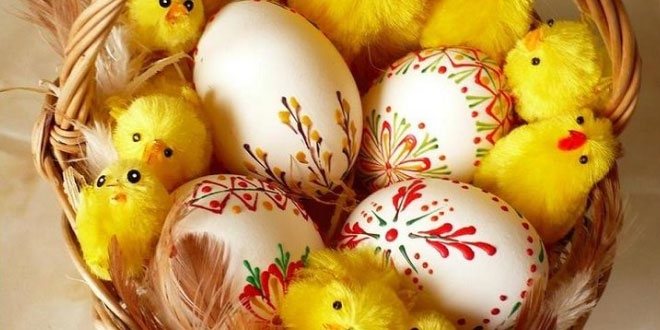Because eggs are a symbol of rebirth. Easter is a Christian festival. For Christians the custom of giving eggs at Easter celebrates new life. Christians remember that Jesus, after dying on the cross, rose from the dead. They believe that, through his resurrection, Jesus defeated death and sin and offers people the promise of eternal life if they follow his teachings.
In Christian times, the egg was a symbol of new life just as a chick might hatch from the egg. The Easter egg tradition may have celebrated the end of the privations of Lent. In the Medieval Europe, eggs were forbidden during Lent as well as other traditional fast days. During the strict Lenten fast of forty days no eggs were eaten. It was traditional to use up all of the household’s eggs before Lent began, which established the tradition of Pancake Day. This was because, in Christian times, the egg was a symbol of new life just as a chick might hatch from the egg. Eggs were viewed as symbols of new life and fertility through the ages. It is believed that for this reason many ancient cultures, including the Ancient Egyptians, Persians, and Romans, used eggs during their spring festivals.
Brighten Up Easter With Naturally Dyed Eggs
Using ingredients straight from your kitchen, these dyed Easter eggs make a fun and festive way to celebrate.
Egg decorating is a festive activity that celebrates the arrival of spring, a season of renewal. The egg, an ancient symbol of rebirth and new life, has a long and storied history tied to holidays and seasonal celebrations around the world, including Easter. In fact, if you’ve hand-dyed eggs, then you have, perhaps unknowingly, participated in one of the oldest known decorative art forms. In 2010, archaeologists in South Africa discovered engraved ostrich eggs dating back around 60,000 years. Since then, eggs have been decorated in every way imaginable, including traditional pysanky (Ukrainian Easter egg decoration) and arts-and-craft inspired decoupage eggs.
This tutorial keeps things simple and relies on natural ingredients, which result in rich, jewel-toned dyes that cover the egg in a wash of color but also let the shell’s speckled beauty show through. Drawing on spring’s color palette for inspiration — from robin’s egg blue to daffodil yellow — the dye recipes shared here require little more than a few kitchen ingredients and a bit of patience.
These dyes are not fast-working like their commercial counterparts; the eggs need to soak for a few hours at a minimum. To achieve the vibrant colors shown here, you must soak your eggs overnight. If you prefer more pastel tones, a shorter soak is effective. Keep in mind that this is not an exact science — colors will vary greatly depending on a number of factors, including the color of your eggs’ shells and the amount of time you soak them for.
Materials
Natural dye ingredients, such as
- 3 cups of yellow onion skins from roughly 8-10 onions
- 3 cups of red cabbage, roughly chopped
- 3 tablespoons ground turmeric
- 3 cups of beets, chopped
- 3 cups frozen blueberries
- 3 tablespoons hibiscus loose-leaf tea
1.5 quarts water per dye ingredient
12 tablespoons white vinegar
 Kids Portal For Parents India Kids Network
Kids Portal For Parents India Kids Network







